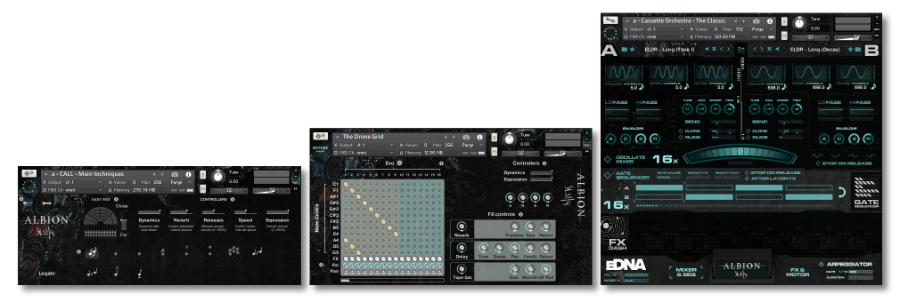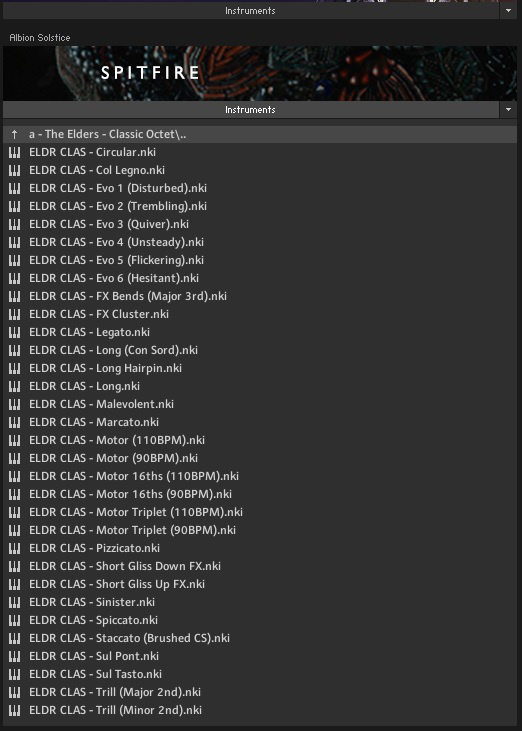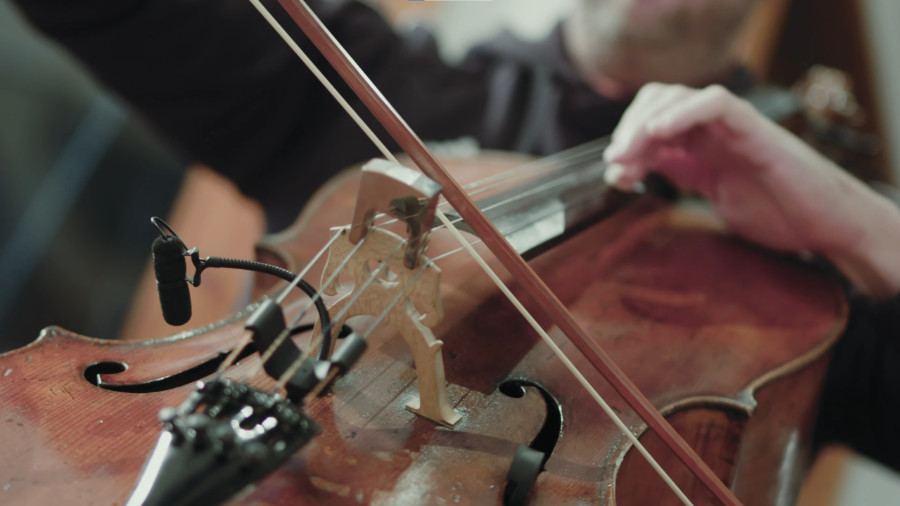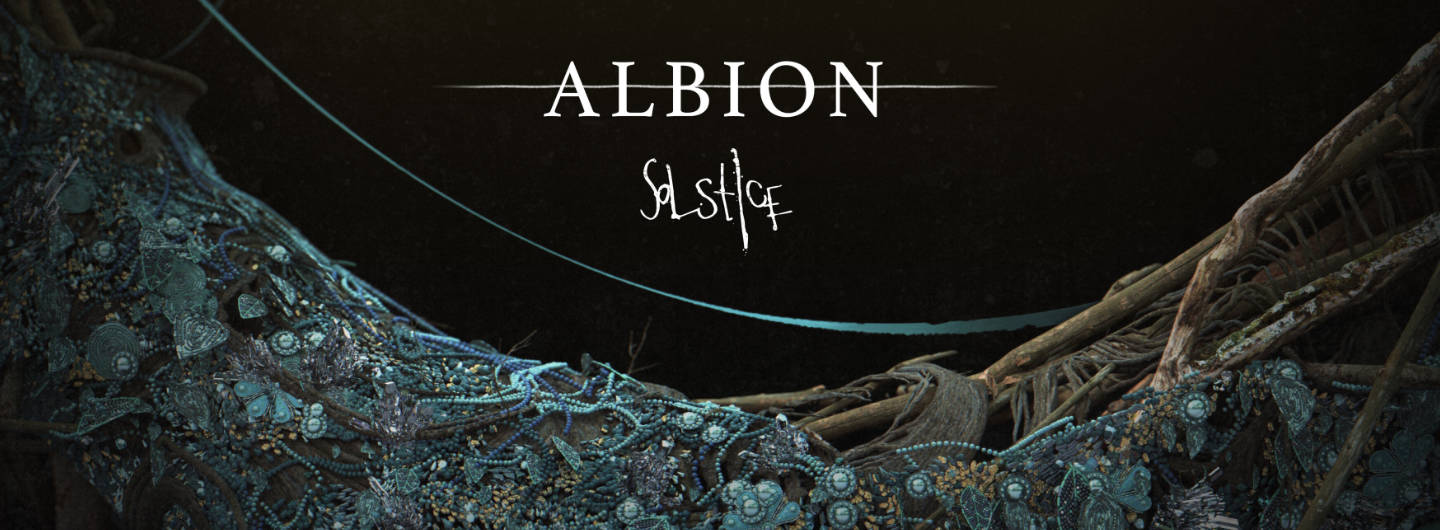Today we will be reviewing Albion Solstice, the latest addition to the famous series of Spitfire Audio’s cinematic scoring tools. Released just a few weeks ago, Albion Solstice is marketed as an exploration of “the visionary artistry from modern, folk, and heritage instruments”.
We were kindly given a review copy by Spitfire Audio to check Albion Solstice out.
OVERVIEW
Albion Solstice features a selection of different sections and unique instrument families taken from folk, Gaelic, Celtic, and other musical traditions, mixed with modern instrumentation and synths. All the instruments are grouped into 3 distinct parts: the Solstice Orchestra, the Cassette Orchestra, and the Drone Grid.
Importantly, and in contrast with previous releases in the series, all players have been recorded in situ at Castlesound Studios in Edinburgh, Scotland. This studio has a rather dry and intimate room sound compared to Air Studios’ lush natural reverb. It, therefore, contributes to giving this library a peculiar character.
The Solstice Orchestra includes 10 different ensembles and a bass soloist. Together they cover more than 230 articulations, a third of which are found in the string sections. These are the included ensembles:
- String Octet – “The Elders Classic” (4 Violins, 2 Violas, 2 Cellos)
- String Sextet – “The Elders Traditional” (4 Violins, 1 Violas, 1 Cellos)
- Solo Bass
- Brass & Winds – “The Callers” (Trombones, Tuba, Euphonium, Clarinets, Saxophone)
- Flutes & Whistles – “The Mystics”
- A Band ensemble made of Hurdy-gurdy, Nyckelharpa, Accordion, etc… – “The Blaggards”
- A female Choir – “The Hosts”
- Electric guitars & Bass – “The Generator Trio”
- Acoustic guitars & Ukelele – “The Gut Circle”
- Bells & Mallets – “The Nursery”
- Percussion – “The Marauders”
The Cassette Orchestra is based on Spitfire Audio’s custom eDNA engine and includes 150 presets made from 750 sound sources taken from the Solstice Orchestra recordings. On top of these presets, the eDNA engine also allows for comprehensive manipulation of these sound sources.
The Drone Grid includes long evolving textures created from the Solstice Orchestra source sounds. It includes 48 presets as well as various randomization options for thousands of possible sound combinations.
All in all, Albion Solstice has A LOT of content. It spans over 74000 samples (almost twice as much as Albion Neo), requiring 73 GB of hard drive space.
THE SOLSTICE INTERFACE(S)
Albion Solstice runs under Native Instruments’ Kontakt & Kontakt Player. Composers who are used to Spitfire Audio’s catalogue will instantly recognize the main instrument interface. The vast majority of included ensembles have their articulations spread over 4 to 5 patches. The articulations are grouped by typical use, with the common ones being separated from the more atypical evolving longs, rhythmic, and FX ones.
Previous eDNA users will feel at home with the Cassette Orchestra, as it shares the same interface. It allows for mixing 2 sound sources and mangling with them using onboard filters, effects, and an arpeggiator.

Finally, the Drone Grid uses the typical pegboard interface design present in other Spitfire Evolutions releases. The grid allows composers to easily map these evolving long sustains to different keys of their keyboard, essentially choosing how much importance each type of evolution will have in the resulting “waves”.
ARTICULATIONS & CONTENT
The Albion releases are meant to give composers ready-to-use cinematic toolkits, with a big range of playing techniques packed all-in-one. Solstice is no exception. However, a slight difference here would be the focus of the library. The previous volumes centred around various sized orchestras that are typical for modern media productions, from orchestral to neo-classical. Albion Solstice takes a slightly different turn by focusing on lesser-known instruments and atypical ensembles that composers wouldn’t necessarily associate together at first glance. This gives Solstice a very strong and unique character, possibly more than any other Albion release so far.
Delving deeper into the patches, a good chunk of the library’s content is made up of many types of evolving long, rhythmic or driving articulations. This makes sense given the library’s focus on brooding atmospheres and dark textures, or “cinematic folk noir” as Spitfire calls it.
Given the extensive amount of content, we will only be able to cover a few of the highlights for each part of the library here. Let’s start with the Solstice Orchestra, which has by far the lion’s share of the overall amount of content.
The Solstice Orchestra
The string sections include some of our favorite articulations like Sul Tasto, Flautando, Con Sordino, Long Hairpins, and more. As usual, Spitfire Audio does a stellar job at capturing these glorious textures. The “Circular Bowing” articulation, where players lean in and out of flautando, also stands out as truly original and can be very effectively used as a background texture for example. The “No Rosin” solo bass patch is another highlight, full of details and really striking. Note that these string patches have either no vibrato or only very subtle gradual vibrato which is in line with the library’s concept and nature. In terms of sonic qualities, these string sections sound a bit akin to the previously released LCO Strings, but with an even more distinct character in the way they are performed.

The string sextet also includes “Cellular Longs”. These are created from player performances set to the D Dorian and G Dorian scales. When playing these patches, each note sounds like a unique interpretation or improvisation: some notes feature slight bends, others feature very subtle motifs, and so on.
String legato techniques were also sampled, including a portamento option. The portamento is not over-emphasized and turns out to sound quite convincing. The legato transition for many intervals feels a bit choppy, however, as there is a noticeable drop of volume each time we transition into a new note. It is not as not fluid as the one in the recent Abbey Road One: Legendary Low Strings expansion for example, and admittedly it is a bit of a disappointment. All in all, this is not a major hindrance as the focus of Albion Solstice is not on melodic lines although we would have appreciated the same fluidity as in the new Abbey Road One product line.
Finally, string short articulations are well covered by spiccato, staccato, marcato, col legno and pizzicato techniques. These are all quite tight in action and have clearly benefitted from good sample editing. They represent a good option for composers looking for more intimate, chamber-style string shorts.
The “Callers” (Brass & Winds) have a balanced set of articulations that match the ones of the strings fairly closely and with the same sound qualities. The Callers also features quite a few instrument-specific techniques.
The Mystics (Flutes & Whistles) have slightly fewer articulations but feature a smoother legato in comparison to the strings. Highlights of this section include the “Flicker” and “Wavering” longs, which have a fragile feel and would be a great choice for intros and ambient tracks in general.
The Blaggards (Band ensemble) is one of the most distinct elements of Albion Solstice. It evokes folky, sometimes even medieval vibes. As the instruments used in this band all have different sound qualities, Spitfire decided to include several types of long techniques and drones (with a different lineup of instruments for each), which is a great idea. The Blaggards also include 2 types of shorts: staccatos and staccatissimos.
The Hosts (Choir) are very distinctive and also contribute heavily to what gives Solstice its unique character. This section of singers includes several sustained vowels of course, with a selection of looped and non-looped samples. One highlight here is the beautiful “Songbath” articulation. For this one, the lineup of 6 female singers all sang according to their own techniques, staying true to their respective cultural and musical traditions. The result is a beautifully surreal and haunting vibe that oozes character.

The Generator Trio (Electric guitars and bass), the Gut Circle (Acoustic), and the Nursery (Bells & Mallets) all feature several pluck/staccato articulations, useful tremolos, and quite a few tempo-based performances. These in particular are really interesting to add drive and momentum to tracks.
Finally, the Marauders (Percussion) can be divided into 2 distinct main parts. The first part consists of a dozen different percussive kits. The second one is a series of “grooves”, or loops, that have been recorded at different tempos. A nice approach with these grooves is that their main rhythmic elements are spread over several notes on the keyboard, meaning that you can add or remove parts of the groove as desired. Therefore, these loops can be used a bit like stems in a finished track.
The string, brass & wind, and electric guitar ensembles also all feature their individual “evolutions”. These are evolving sustains of different vibes which are very useful to help sculpting a performance.
The other common articulation that is shared between instrument families is the “Motor” articulation. These are, in essence, repeating figures, akin to measured tremolos. The figures have been recorded at several tempos, but can also be tempo-synced to match a particular project tempo. In practice, they are very useful to add momentum and drive to a track, without resorting to classic string ostinato figures.
Overall, all these playing techniques are recorded with great expertise as usual. Also, the samples have plenty of detail thanks to the special close mics used (more on this later!). Most long articulations seem to have been recorded with 2 to 3 dynamic layers, but their exact number is sometimes tricky to confirm as the Kontakt patches are locked and non-editable. All in all, the patches and presets represent a magnificent, almost unending palette of textures to choose from.
The Cassette Orchestra
Next, users will find the “Cassette Orchestra”. Based on Spitfire Audio’s eDNA engine and similar to the Stephensons Steam Band of previous Albion volumes. This part of the library provides dozens of vibey presets that sound very inspiring and play perfectly well with the vibe of the library. These presets can be particularly useful for setting up a certain mood in intros or outros for example. For composers wanting more customization options, it is also possible to load up the Cassette Orchestra engine with source sounds from the Solstice Orchestra. The engine then allows for blending two sources together, while applying different filters and effects.
The Drone Grid
Finally, the last part of the library is the Drone Grid. This engine and interface will be very familiar to composers who own any recent libraries of the Spitfire Evolution product line. The different waves & evolutions are very effective in conveying a sense of drama and emotion. Given the eclectic nature of the instrument lineup included, some combinations of evolutions work better than others: in our listening sessions, the Hurdy Gurdy was probably better off left on its own separate evolution, as it can quickly take over the focus of the overall sound.

MICROPHONE MIXES
As mentioned previously, all players in Albion Solstice have been recorded in situ (meaning at their respective position in the room), in a fairly dry studio. The library offers four microphone signals: Close, Outrigger, Room, and a pre-designed mix by Jake Jackson (which is also the default signal activated). The Close signal is extremely effective at pushing forward the string sections, as Spitfire Audio used high-end DPA clip-on microphones on the instruments.
Here is a simple phrase we recorded to showcase the different microphone signals. Onboard reverb has been switched off and a limiter has been applied to the mix bus for gain staging.
CLOSE MIC
OUTRIGGER MICS
ROOM MICS
JAKE JACKSON MIX
CONCLUSION
With Albion Solstice, Spitfire Audio delivers a very interesting release, maybe even the most unique volume in the Albion series so far. The library offers a huge amount of quality content along with innovative combinations of folkloristic, historic, and electronic instruments.
Recorded with a variety of microphone positions, Albion Solstice also does a great job at taking these unusual instruments and putting them in a cinematic context. On this front, the onboard custom IR is very effective.
Albion Solstice has a beautiful but strong character, so the final verdict for many composers will heavily depend on if the vibe of the library can offer new inspiration for their particular workflows. From our point of view, Spitfire Albion not only provides a unique and fresh alternative sound palette for film and media composers, but also offers a ton of sonic material for producers of ambient, electronic, or darker pop music.
Pros
- Huge amount of content
- Comprehensive and varied selection of patches from different instrument families
- Great sounding short articulations
- Quality samples, full of intricate details that add to the character of music pieces
Cons
- String legato not up to par with Spitfire Audio’s latest releases
- No mic selection available for the Drone Grid
RECOMMENDED: 8/10
Albion Solstice is available as a download from the Spitfire Audio online shop for an introductory price of €291.86 (regular price: €449).


0 comments on “Spitfire Audio – Albion Solstice (Review)”